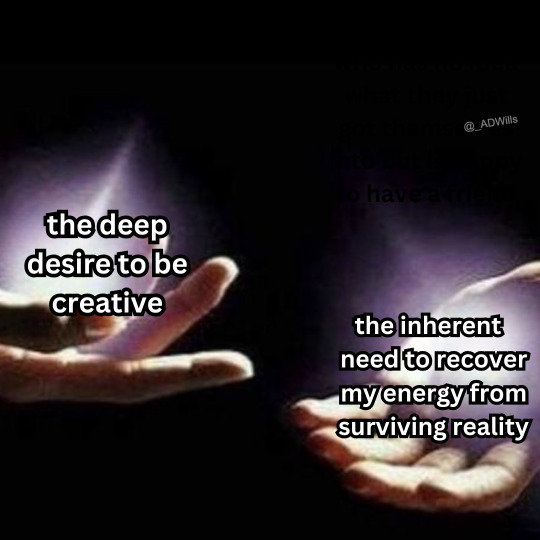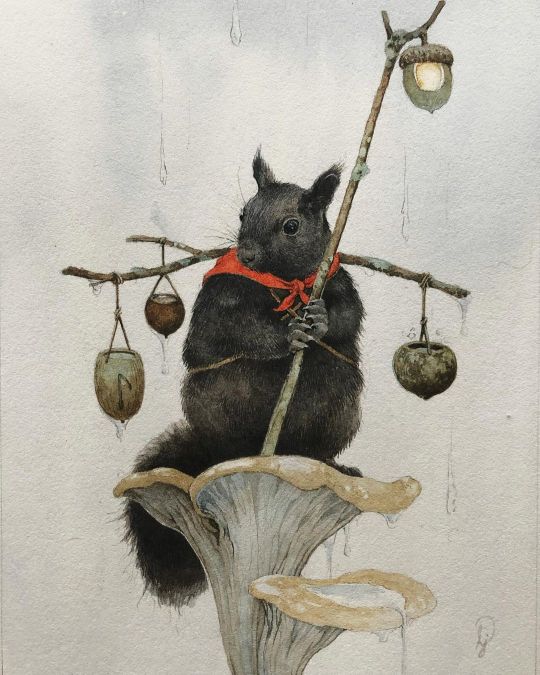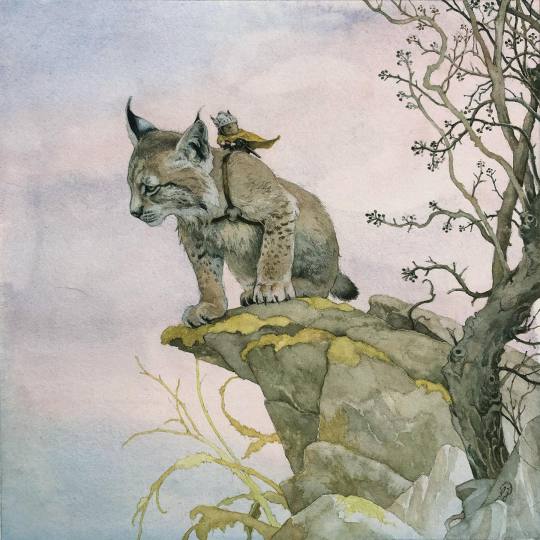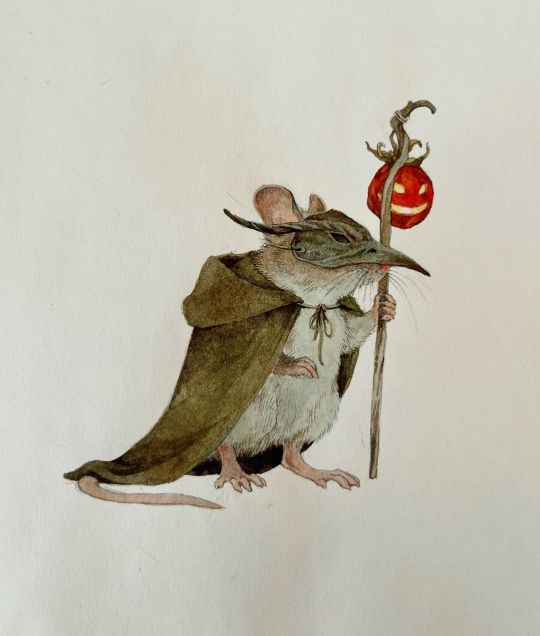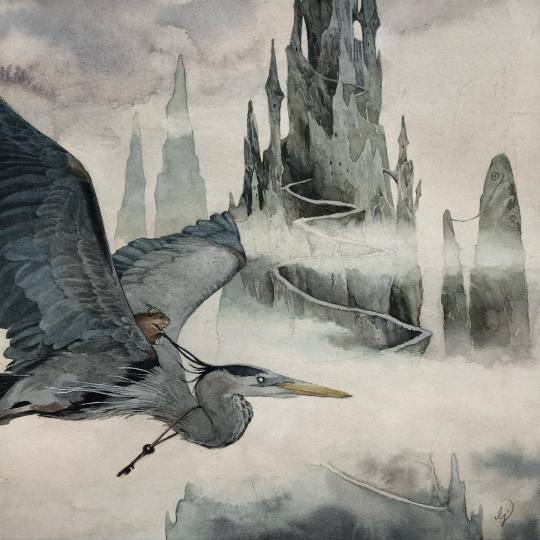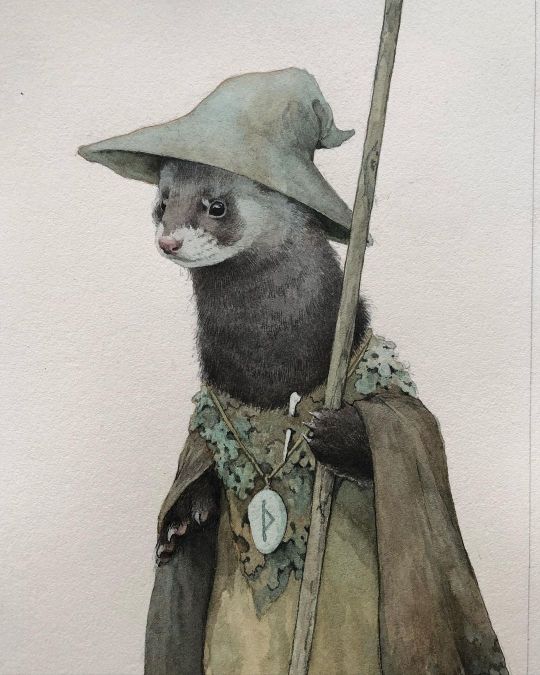Don't wanna be here? Send us removal request.
Text
A general cane guide for writers and artists (from a cane user, writer, and artist!)
Disclaimer: Though I have been using a cane for 6 years, I am not a doctor, nor am I by any means an expert. This guide is true to my experience, but there are as many ways to use a cane as there are cane users!
This guide will not include: White canes for blindness, crutches, walkers, or wheelchairs as I have no personal experience with these.
This is meant to be a general guide to get you started and avoid some common mishaps/misconceptions in your writing, but you absolutely should continue to do your own research outside of this guide!
This is NOT a medical resource!!! And never tell a real person you think they're using a cane wrong!
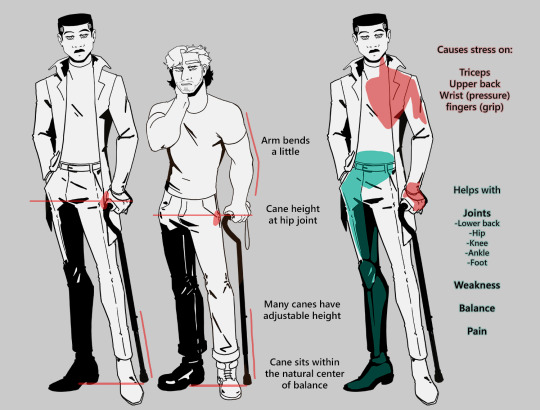
The biggest recurring problem I've seen is using the cane on the wrong side. The cane goes on the opposite side of the pain! If your character has even-sided pain or needs it for balance/weakness, then use the cane in the non-dominant hand to keep the dominant hand free. Some cane users also switch sides to give their arm a rest!
A cane takes about 20% of your weight off the opposite leg. It should fit within your natural gait and become something of an extension of your body. If you need more weight off than 20%, then crutches, a walker, or a wheelchair is needed.
Putting more pressure on the cane, using it on the wrong side, or having it at the wrong height can make it less effective, and can cause long term damage to your body from improper pressure and posture. (Hugh Laurie genuinely hurt his body from years of using a cane wrong on House!)
(some people elect to use a cane wrong for their personal situation despite this, everyone is different!)
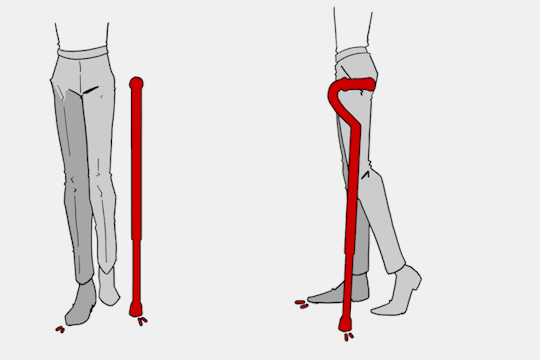
(an animated GIF of a cane matching the natural walking gait. It turns red when pressure is placed on it.)
When going up and down stairs, there is an ideal standard: You want to use the handrail and the cane at the same time, or prioritize the handrail if it's only on one side. When going up stairs you lead with your good leg and follow with the cane and hurt leg together. When going down stairs you lead with the cane and the bad leg and follow with the good leg!
Realistically though, many people don't move out of the way for cane users to access the railing, many stairs don't have railings, and many are wet, rusty, or generally not ideal to grip.
In these cases, if you have a friend nearby, holding on to them is a good idea. Or, take it one step at a time carefully if you're alone.
Now we come to a very common mistake I see... Using fashion canes for medical use!
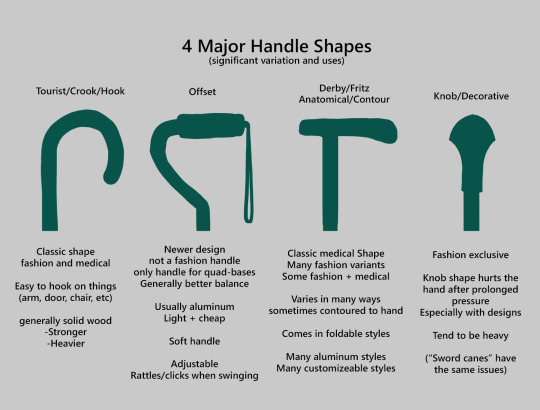
(These are 4 broad shapes, but there is INCREDIBLE variation in cane handles. Research heavily what will be best for your character's specific needs!)
The handle is the contact point for all the weight you're putting on your cane, and that pressure is being put onto your hand, wrist, and shoulder. So the shape is very important for long term use!
Knob handles (and very decorative handles) are not used for medical use for this reason. It adds extra stress to the body and can damage your hand to put constant pressure onto these painful shapes.
The weight of a cane is also incredibly important, as a heavier cane will cause wear on your body much faster. When you're using it all day, it gets heavy fast! If your character struggles with weakness, then they won't want a heavy cane if they can help it!
This is also part of why sword canes aren't usually very viable for medical use (along with them usually being knob handles) is that swords are extra weight!
However, a small knife or perhaps a retractable blade hidden within the base might be viable even for weak characters.
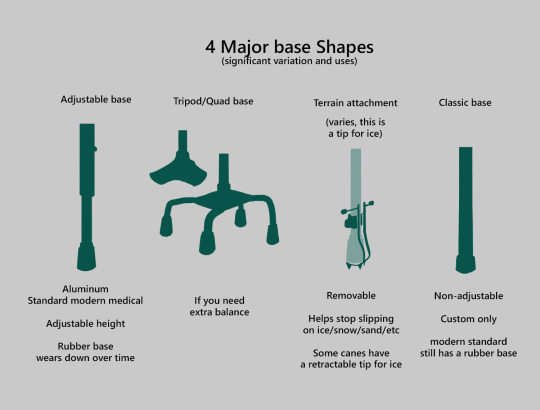
Bases have a lot of variability as well, and the modern standard is generally adjustable bases. Adjustable canes are very handy if your character regularly changes shoe height, for instance (gotta keep the height at your hip!)
Canes help on most terrain with their standard base and structure. But for some terrain, you might want a different base, or to forego the cane entirely! This article covers it pretty well.
Many cane users decorate their canes! Stickers are incredibly common, and painting canes is relatively common as well! You'll also see people replacing the standard wrist strap with a personalized one, or even adding a small charm to the ring the strap connects to. (nothing too large, or it gets annoying as the cane is swinging around everywhere)
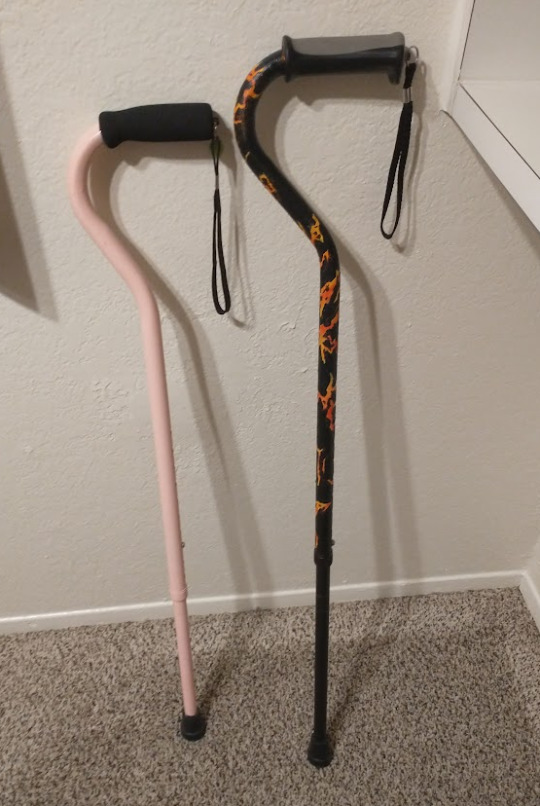
(my canes, for reference)
If your character uses a cane full time, then they might also have multiple canes that look different aesthetically to match their outfits!
When it comes to practical things outside of the cane, you reasonably only have one hand available while it's being used. Many people will hook their cane onto their arm or let it dangle on the strap (if they have one) while using their cane arm, but it's often significantly less convenient than 2 hands. But, if you need 2 hands, then it's either setting the cane down or letting it hang!
For this reason, optimizing one handed use is ideal! Keeping bags/items on the side of your free hand helps keep your items accessible.
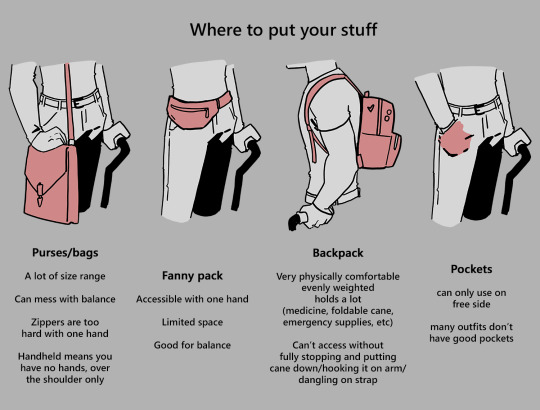
When sitting, the cane either leans against a wall or table, goes under the chair, or hooks onto the back of the chair. (It often falls when hanging off of a chair, in my experience)
When getting up, the user will either use their cane to help them balance/support as they stand, or get up and then grab their cane. This depends on what it's being used for (balance vs pain when walking, for instance!)
That's everything I can think of for now. Thank you for reading my long-but-absolutely-not-comprehensive list of things to keep in mind when writing or drawing a cane user!
Happy disability pride month! Go forth and make more characters use canes!!!
93K notes
·
View notes
Text
Super powers have started to appear in the general population. However, unlike comics, there are no secondary powers to make one immune to the actual physics of one’s power. This has led to some interesting case studies.
5K notes
·
View notes
Text
Writing tip- write a poem or song for that new piece of worldbuilding you just came up with.
Some words sound better than than other words in poems and songs. This type of media has rhythm, so trying to incorporate worldbuilding may require making up a type of bird or idiom to keep with the beat, aka more bang for your buck.
Poems and songs rhyme, which forces you to think and make the story in that media more complex. It leaves places where it can be connected to something else or expanded.
Poems and songs, like all media, are written for a reason. You may already know why that piece of worldbuilding exists, writting either lets you test it out. Would someone really sing this? Why would they sing this? Who are they singing to?
In conclusion, Im in my poetry writing phase again, this time it is not because my metal health is in the gutter👍
A little poll as a non-binding parting gift:
43 notes
·
View notes
Text



Armadillidium i found in my yard dying from iridiovirus
38 notes
·
View notes
Text


———
C. A. Singh • To open the earth and feed it remorse
5-7-23
37 notes
·
View notes
Photo

Adolf Echtler (German, 1843-1914) Girl with Flowers, ca. 1900 Museum of Fine Arts, Budapest
17 notes
·
View notes
Text
Writing advice from my uni teachers:
If your dialog feels flat, rewrite the scene pretending the characters cannot at any cost say exactly what they mean. No one says “I’m mad” but they can say it in 100 other ways.
Wrote a chapter but you dislike it? Rewrite it again from memory. That way you’re only remembering the main parts and can fill in extra details. My teacher who was a playwright literally writes every single script twice because of this.
Don’t overuse metaphors, or they lose their potency. Limit yourself.
Before you write your novel, write a page of anything from your characters POV so you can get their voice right. Do this for every main character introduced.
232K notes
·
View notes
Text
writing tip:
if you push buttons on a keyboard, letters will appear on the screen. and with that power you can do anything
169K notes
·
View notes
Text
I cannot emphasize enough how much you need to read thoroughly through the terms of any publication before you send your writing to them. It is mandatory that you know and understand what rights you’re giving away when you’re trying to get published.
Just the other day I was emailed by a relatively new indie journal looking for writers. They made it very clear that they did not pay writers for their work, so I figured I’d probably be passing, but I took a look at their Copyright policy out of curiosity and it was a nightmare. They wanted “non-exclusive, irrevocable, royalty-free, perpetual, worldwide license and right to use, display, reproduce, distribute, and publish the Work on the internet and on or in any medium” (that’s copy and pasted btw) and that was the first of 10 sections on their Copyright agreement page. Yikes. That’s exactly the type of publishing nightmare you don’t want to be trapped in.
Most journals will ask for “First North American Rights” or a variation on “First Rights” which operate under the assumption that all right revert back to you and they only have the right to be the first publishers of the work. That is what you need to be looking for because you do want to retain all the rights to your work.
You want all rights to revert back to you upon publication in case you, say, want to publish it again in the future or use it for a bookmark or post it on your blog, or anything else you might want to do with the writing you worked hard on. Any time a publisher wants more than that, be very suspicious. Anyone who wants to own your work forever and be able to do whatever they want with it without your permission is not to be trusted. Anyone who wants all that and wants you to sign away your right to ever be paid for your work is running a scam.
Protect your writing. It’s not just your intellectual property, it’s also your baby. You worked hard on it. You need to do the extra research to protect yourself so that a scammer (or even a well meaning start up) doesn’t steal you work right from under you nose and make money off of it.
75K notes
·
View notes
Text
Los Tulpas

Alexandra David Neel
Ok, uno de los temas que me vienen preguntando un montón es ¿Qué es un Tulpa?. Y cuándo respondo Tulpa (སྤྲུལ་པ) o sprul-spa es “emanación” todos me preguntan si los Tulpas son inmortales, etc. Para entender que es exactamente un tulpa necesitamos contextualizarlo. Y para esto, necesitamos primero definir los contextos en los que ese término aparece.
En el Budismo
Vamos primero por el contexto budista: dentro del Vajrayana, como en cualquier sistema Mahayana, se acepta la doctrina del Trikaya o tres cuerpos (de los que hablé aquí: http://budaenlayerba.tumblr.com/post/13511234273/trikaya-o-skorponok-ten%C3%ADa-raz%C3%B3n-vieron ). En ese sistema, un Nirmanakaya es, esencialmente, una representación física de la iluminación. Es decir: el Buda Sakyamuni es un Nirmanakaya. Una Stupa o un Mantra escrito, también. Esto es en común con el Budismo Nikaya, que llama a las emanaciones “Nirmita” o निर्मित.
La diferencia principal dentro entre el Mahayana y el Budismo Nikaya es que en el Nikaya, los Nirmitas son potestad del Buda, solamente; es decir que el Buda emana todo el resto de las emanaciones, siendo el Buda la fuente. En el Mahayana, el Buda mismo es una emanación del Dharmakaya, el cuerpo de la realidad y no solamente el Buda puede generar emanaciones, sino que los Bodhisattvas y los Siddhas pueden hacerlo, siendo esencialmente un Siddhi, una competencia técnica (como lo define Vasubandhu).
Entonces, un Tulpa en el contexto Mahayana es una emanación mágica, generada por el poder concentrativo de un Yogi avanzado. Es, esencialmente, una herramienta del Yogi para interactuar con las personas y ayudarlas en su camino. Múltiples veces esto sucede en los textos Mahayanas: Maitreyanatha emana un perro moribundo para probar a Asanga, Vimalakirti emana una mansión celestial para enseñarle a Sariputra, las mismas tierras puras son una forma de Tulpa, emanadas por un Buda. Esencialmente, son la manifestación directa de los medios hábiles. No necesariamente son emanadas por Budas, pero si requieren un nivel avanzado de concentración y visualizacion y crucialmente para el próximo punto, son una extensión de la voluntad de quién las emana. Veámos el otro contexto.
En Occidente (hasta los 2000’s)
Entra en escena Alexandra David-Neel, sobre quién escribí acá (http://budaenlayerba.tumblr.com/post/112628390020/que-opinon-te-merece-alexandra-david-n%C3%A9el-me) y acá (http://budaenlayerba.tumblr.com/post/147596707185/hola-les-qeria-preguntar-q-es-una-emanacion-lei-a). Sin lugar a dudas, uno de los personajes más fascinantes del siglo XX. Una Anarquista Feminista (que había vivido en un campo proto-comunista) con vínculos con la Teosofía, pasó de huir de su casa y querer ser marinera a cantante de ópera y probablemente la exploradora más importante del siglo XX. Su viaje más famoso es llegar a Lhasa, la capital del Tíbet, cuándo estaba prohibido para los occidentales y encontrarse con el XIII Dalai Lama en Kalimpong.
De Alexandra David-Neel nos han llegado muchos títulos (escribió treinta libros en su vida) sobre el Tíbet. Entre mucha información valiosa, ella mezclaba mucho con el orientalismo post-victoriano que tendía a exotizar a los tibetanos…cosa que, en general, comparte con su generación y no le quita valor. Pero su aporte más resonante es el del tulpa que describe no como una aplicación de los medios hábiles, sino como una especie de Golems creados por la mente, que son usados como asesinos y que tienen su propia voluntad. De esta manera, los Tulpas parecen los genios / djinn de los cuentos árabes. Ella describe estos casos de la siguiente manera:
“Los Magos Tibetanos también relatan casos en los que los Tulpa son enviados a una misión, pero no la llevan a cabo y siguen sus peregrinaciones como un muñeco malicioso y semiconciente…”
-Magic & Mystery in Tibet, A.David-Neel
Ella misma relata como, tras un par de sesiones de meditación, crea un Tulpa con la forma de un fraile, de carácter malicioso que se rebela y debe ser destruido con ayuda de unos tibetanos. Por un lado, David-Neel reconoce que puede haber sido una alucinación psicótica de su parte; pero por otro, dice que múltiples tibetanos vieron al Tulpa y hablaron con él, lo que indica que para ella existía de forma independiente.
Esta idea del Tulpa como algo independiente tiene más relación, creo, con el concepto de forma-pensamiento, que Annie Besant establece dentro de la teosofía. En Teosofía, si bien hay varios tipos de forma-pensamiento, la idea básica es que los pensamientos tienen una existencia discreta. La conciencia es la agregación de pensamientos: si uno piensa de forma sostenida en algo, sostiene Besant, ese algo se vuelve en cierta manera real e independiente. Si uno mantiene la concentración, esa forma-pensamiento gana un “alma” que lo vuelve, por lo menos, semi independiente.
Este concepto es, para mí, mucho más cercano a lo que David-Neel relata que la idea de un Tulpa en el contexto Budista. Después de todo, un Tulpa budista puede ser una frase que un Buda escriba y que al verla, provoque la iluminación en alguien. La famosa respuesta de Zhao Zhou (”Mu”) es, esencialmente, un Tulpa, la corporización sonora de un medio hábil. En ningún lugar de los textos budistas el Tulpa se puede rebelar o ganar un alma…esto es, esencialmente, un concepto occidental previo (ganado seguramente en la época en que David-Neel era una ávida teósofa) que luego fue “confirmado” en el Tíbet. Cómo siempre, la confirmación requiere forzamiento y así hemos recibido un concepto occidental con una palabra tibetana designándolo para exotizarlo.
Pero lo interesante de este concepto no es sólo su historia, sino qué ha pasado con él desde el surgimiento de internet…
Los Tulpas contemporáneos
Lo más interesante, me parece, es que el concepto no ha desaparecido ni se ha mantenido, sino que ha mutado de forma interesante. En los años 2000’s, un grupo de gente que seguía una corriente caóte busco actualizar el concepto de Tulpas. Tras varios años de exploración, surgió una comunidad pequeña pero muy activa en Internet, dedicada a la Tulpamancia o la creación sistemática de Tulpas. Probablemente su sitio más popular sea Reddit (https://www.reddit.com/r/Tulpas/) pero también tienen páginas propias.
Los Tulpas en esta iteración no son ni los medios hábiles budistas ni los golems teosóficos: son esencialmente objetos mentales dentro de la corriente mental de quién practica tulpamancia, creados de forma sistemática. Esencialmente, son como fragmentos de personalidades diferentes a la personalidad con la cuál se identifica el sujeto, existentes solo en su psiquis, como una versión interna del famoso trastorno de personalidades múltiples (trastorno extremadamente Hollywoodense, debo decir, dado que muy pocas veces son estructuras estables) o si bien no encontré un tulpamante que me hiciera la referencia, la experiencia de los personajes en los libros dos, tres y cuatro de Duna.
Es decir: los Tulpamantes invierten tiempo y energía en imaginar y crear un amigo imaginario en su psíquis. ¿Para qué uno querría esto? Es una pregunta compleja, que requiere una contextualización de los Tulpamantes: en muchos casos, para tener simplemente alguien con quien hablar. Para placer (muchos tulpamantes tienen sesiones imaginadas y soñadas de encuentros eróticos con sus tulpas). Para sentirse mejor. Para explorar. Hay miles de respuestas, que tienden a variar según el contexto de la pregunta; en general, los tulpamantes son jóvenes, con cierto grado de angustia presente y no poseen formación académica o meditativa previa.
Pero lo interesante es que como estrategia de adaptación, al parecer tiene su uso: Estudios como el del Dr.Isler (http://pubs.sciepub.com/rpbs/5/2/1/) señalan que son estrategias defensivas para estructurar a sujetos que de por sí son lábiles. Es decir, tiene un efecto significante y curativo para las personas que lo practican. Por otro lado, los mismos tulpamantes están conscientes de lo que un profesional de la salud mental puede pensar cuándo los escucha hablar. Para esto, tienen una guía de trabajo: https://tulpa.io/clinical-perspectives.
Es interesante que más allá de las aplicaciones de salud, muchos sistemas de visualización creativa tienden a buscar un Guía, un conjunto de aliados o gente que pueda ayudarnos mediante la meditación. Sean los guías chamánicos (http://www.shamanicjourney.com/category/power-animals-totems-spirit-guides) o visualizaciones creativas (https://www.inc.com/jeff-degraff/picture-this-using-visual-aids-to-inspire-creativity.html) la idea de ser guiado por la imaginación está presente en múltiples entornos. En el mismo Budismo las prácticas de visualización de Tierras Puras, etc…hacen uso de la imaginación para inspirar y meditar.
Por lo que, en cierta forma, los Tulpas vuelven al Budismo y a la meditación. ¿Medio hábil de un Buda o simple casualidad? No lo sé, pero mientras puedan ayudar a que jóvenes angustiados estén mejor, no creo que ningún Buda pensara que no son útiles.
6 notes
·
View notes
Text
Very useful
Words for Skin Tone | How to Describe Skin Color
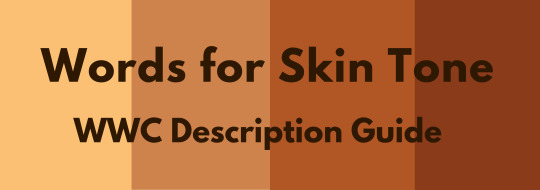
We discussed the issues describing People of Color by means of food in Part I of this guide, which brought rise to even more questions, mostly along the lines of “So, if food’s not an option, what can I use?” Well, I was just getting to that!
This final portion focuses on describing skin tone, with photo and passage examples provided throughout. I hope to cover everything from the use of straight-forward description to the more creatively-inclined, keeping in mind the questions we’ve received on this topic.
Standard Description
Basic Colors

Pictured above: Black, Brown, Beige, White, Pink.
“She had brown skin.”
This is a perfectly fine description that, while not providing the most detail, works well and will never become cliché.
Describing characters’ skin as simply brown or beige works on its own, though it’s not particularly telling just from the range in brown alone.
Complex Colors
These are more rarely used words that actually “mean” their color. Some of these have multiple meanings, so you’ll want to look into those to determine what other associations a word might have.

Pictured above: Umber, Sepia, Ochre, Russet, Terra-cotta, Gold, Tawny, Taupe, Khaki, Fawn.
Complex colors work well alone, though often pair well with a basic color in regards to narrowing down shade/tone.
For example: Golden brown, russet brown, tawny beige…
As some of these are on the “rare” side, sliding in a definition of the word within the sentence itself may help readers who are unfamiliar with the term visualize the color without seeking a dictionary.
“He was tall and slim, his skin a russet, reddish-brown.”
Comparisons to familiar colors or visuals are also helpful:
“His skin was an ochre color, much like the mellow-brown light that bathed the forest.”
Modifiers
Modifiers, often adjectives, make partial changes to a word.The following words are descriptors in reference to skin tone.
Dark - Deep - Rich - Cool
Warm - Medium - Tan
Fair - Light - Pale
Rich Black, Dark brown, Warm beige, Pale pink…
If you’re looking to get more specific than “brown,” modifiers narrow down shade further.
Keep in mind that these modifiers are not exactly colors.
As an already brown-skinned person, I get tan from a lot of sun and resultingly become a darker, deeper brown. I turn a pale, more yellow-brown in the winter.
While best used in combination with a color, I suppose words like “tan” “fair” and “light” do work alone; just note that tan is less likely to be taken for “naturally tan” and much more likely a tanned White person.
Calling someone “dark” as description on its own is offensive to some and also ambiguous. (See: Describing Skin as Dark)
Undertones
Undertones are the colors beneath the skin, seeing as skin isn’t just one even color but has more subdued tones within the dominating palette.
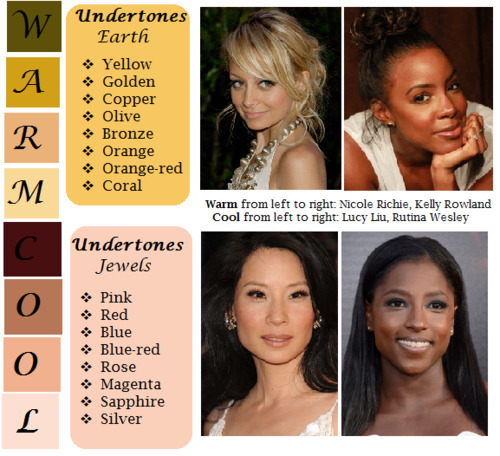
pictured above: warm / earth undertones: yellow, golden, copper, olive, bronze, orange, orange-red, coral | cool / jewel undertones: pink, red, blue, blue-red, rose, magenta, sapphire, silver.
Mentioning the undertones within a character’s skin is an even more precise way to denote skin tone.
As shown, there’s a difference between say, brown skin with warm orange-red undertones (Kelly Rowland) and brown skin with cool, jewel undertones (Rutina Wesley).
“A dazzling smile revealed the bronze glow at her cheeks.”
“He always looked as if he’d ran a mile, a constant tinge of pink under his tawny skin.”
Standard Description Passage
“Farah’s skin, always fawn, had burned and freckled under the summer’s sun. Even at the cusp of autumn, an uneven tan clung to her skin like burrs. So unlike the smooth, red-brown ochre of her mother, which the sun had richened to a blessing.”
-From my story “Where Summer Ends” featured in Strange Little Girls
Here the state of skin also gives insight on character.
Note my use of “fawn” in regards to multiple meaning and association. While fawn is a color, it’s also a small, timid deer, which describes this very traumatized character of mine perfectly.
Though I use standard descriptions of skin tone more in my writing, at the same time I’m no stranger to creative descriptions, and do enjoy the occasional artsy detail of a character.
Creative Description
Whether compared to night-cast rivers or day’s first light…I actually enjoy seeing Characters of Colors dressed in artful detail.
I’ve read loads of descriptions in my day of white characters and their “smooth rose-tinged ivory skin”, while the PoC, if there, are reduced to something from a candy bowl or a Starbucks drink, so to actually read of PoC described in lavish detail can be somewhat of a treat.
Still, be mindful when you get creative with your character descriptions. Too many frills can become purple-prose-like, so do what feels right for your writing when and where. Not every character or scene warrants a creative description, either. Especially if they’re not even a secondary character.
Using a combination of color descriptions from standard to creative is probably a better method than straight creative. But again, do what’s good for your tale.
Natural Settings - Sky
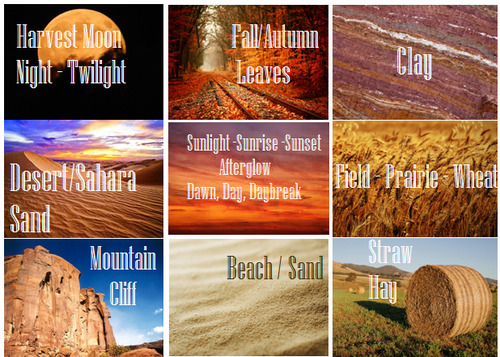
Pictured above: Harvest Moon -Twilight, Fall/Autumn Leaves, Clay, Desert/Sahara, Sunlight - Sunrise - Sunset - Afterglow - Dawn- Day- Daybreak, Field - Prairie - Wheat, Mountain/Cliff, Beach/Sand/Straw/Hay.
Now before you run off to compare your heroine’s skin to the harvest moon or a cliff side, think about the associations to your words.
When I think cliff, I think of jagged, perilous, rough. I hear sand and picture grainy, yet smooth. Calm. mellow.
So consider your character and what you see fit to compare them to.
Also consider whose perspective you’re describing them from. Someone describing a person they revere or admire may have a more pleasant, loftier description than someone who can’t stand the person.
“Her face was like the fire-gold glow of dawn, lifting my gaze, drawing me in.”
“She had a sandy complexion, smooth and tawny.”
Even creative descriptions tend to draw help from your standard words.
Flowers
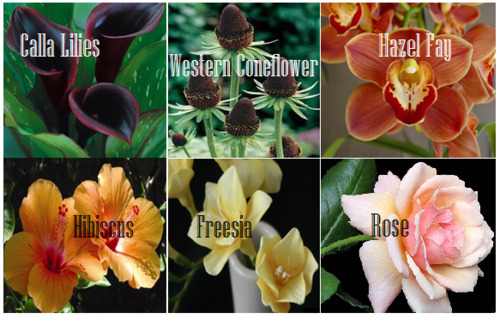
Pictured above: Calla lilies, Western Coneflower, Hazel Fay, Hibiscus, Freesia, Rose
It was a bit difficult to find flowers to my liking that didn’t have a 20 character name or wasn’t called something like “chocolate silk” so these are the finalists.
You’ll definitely want to avoid purple-prose here.
Also be aware of flowers that most might’ve never heard of. Roses are easy, as most know the look and coloring(s) of this plant. But Western coneflowers? Calla lilies? Maybe not so much.
“He entered the cottage in a huff, cheeks a blushing brown like the flowers Nana planted right under my window. Hazel Fay she called them, was it?”
Assorted Plants & Nature

Pictured above: Cattails, Seashell, Driftwood, Pinecone, Acorn, Amber
These ones are kinda odd. Perhaps because I’ve never seen these in comparison to skin tone, With the exception of amber.
At least they’re common enough that most may have an idea what you’re talking about at the mention of “pinecone.“
I suggest reading out your sentences aloud to get a better feel of how it’ll sounds.
"Auburn hair swept past pointed ears, set around a face like an acorn both in shape and shade.”
I pictured some tree-dwelling being or person from a fantasy world in this example, which makes the comparison more appropriate.
I don’t suggest using a comparison just “cuz you can” but actually being thoughtful about what you’re comparing your character to and how it applies to your character and/or setting.
Wood

Pictured above: Mahogany, Walnut, Chestnut, Golden Oak, Ash
Wood can be an iffy description for skin tone. Not only due to several of them having “foody” terminology within their names, but again, associations.
Some people would prefer not to compare/be compared to wood at all, so get opinions, try it aloud, and make sure it’s appropriate to the character if you do use it.
“The old warlock’s skin was a deep shade of mahogany, his stare serious and firm as it held mine.”
Metals

Pictured above: Platinum, Copper, Brass, Gold, Bronze
Copper skin, brass-colored skin, golden skin…
I’ve even heard variations of these used before by comparison to an object of the same properties/coloring, such as penny for copper.
These also work well with modifiers.
“The dress of fine white silks popped against the deep bronze of her skin.”
Gemstones - Minerals
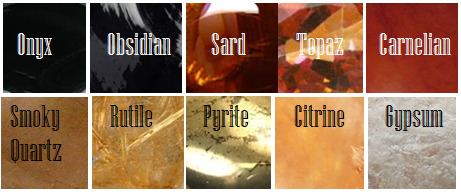
Pictured above: Onyx, Obsidian, Sard, Topaz, Carnelian, Smoky Quartz, Rutile, Pyrite, Citrine, Gypsum
These are trickier to use. As with some complex colors, the writer will have to get us to understand what most of these look like.
If you use these, or any more rare description, consider if it actually “fits” the book or scene.
Even if you’re able to get us to picture what “rutile” looks like, why are you using this description as opposed to something else? Have that answer for yourself.
“His skin reminded her of the topaz ring her father wore at his finger, a gleaming stone of brown, mellow facades.”
Physical Description
Physical character description can be more than skin tone.
Show us hair, eyes, noses, mouth, hands…body posture, body shape, skin texture… though not necessarily all of those nor at once.
Describing features also helps indicate race, especially if your character has some traits common within the race they are, such as afro hair to a Black character.
How comprehensive you decide to get is up to you. I wouldn’t overdo it and get specific to every mole and birthmark. Noting defining characteristics is good, though, like slightly spaced front teeth, curls that stay flopping in their face, hands freckled with sunspots…
General Tips
Indicate Race Early: I suggest indicators of race be made at the earliest convenience within the writing, with more hints threaded throughout here and there.
Get Creative On Your Own: Obviously, I couldn’t cover every proper color or comparison in which has been “approved” to use for your characters’ skin color, so it’s up to you to use discretion when seeking other ways and shades to describe skin tone.
Skin Color May Not Be Enough: Describing skin tone isn’t always enough to indicate someone’s ethnicity. As timeless cases with readers equating brown to “dark white” or something, more indicators of race may be needed.
Describe White characters and PoC Alike: You should describe the race and/or skin tone of your white characters just as you do your Characters of Color. If you don’t, you risk implying that White is the default human being and PoC are the “Other”).
PSA: Don’t use “Colored.” Based on some asks we’ve received using this word, I’d like to say that unless you or your character is a racist grandmama from the 1960s, do not call People of Color “colored” please.
Not Sure Where to Start? You really can’t go wrong using basic colors for your skin descriptions. It’s actually what many people prefer and works best for most writing. Personally, I tend to describe my characters using a combo of basic colors + modifiers, with mentions of undertones at times. I do like to veer into more creative descriptions on occasion.
Want some alternatives to “skin” or “skin color”? Try: Appearance, blend, blush, cast, coloring, complexion, flush, glow, hue, overtone, palette, pigmentation, rinse, shade, sheen, spectrum, tinge, tint, tone, undertone, value, wash.
Skin Tone Resources
List of Color Names
The Color Thesaurus
Skin Undertone & Color Matching
Tips and Words on Describing Skin
Photos: Undertones Described (Modifiers included)
Online Thesaurus (try colors, such as “red” & “brown”)
Don’t Call me Pastries: Creative Skin Tones w/ pics I
Writing & Description Guides
WWC Featured Description Posts
WWC Guide: Words to Describe Hair
Writing with Color: Description & Skin Color Tags
7 Offensive Mistakes Well-intentioned Writers Make
I tried to be as comprehensive as possible with this guide, but if you have a question regarding describing skin color that hasn’t been answered within part I or II of this guide, or have more questions after reading this post, feel free to ask!
~ Mod Colette
170K notes
·
View notes
Note
a guy unknowingly gets a tapeworm, it slowly feeding off the food and water he eats until its stretches from his throat all the way through his intestines. Once it has him completely full, it secretes a vicious slime that keeps it attached to him, and clogs his vocal cords. Now he has to eat obscene amounts of food to satiate it, it growing thicker and filling him up more.
He can't call for help since he can't speak, and the tapeworm keeps him alive to continue taking up residence. He thinks his situation can't get any worse until he feels it split inside him. It produces asexually and another one, a thin and small tapeworm in its first phase, slithers into his pussy next. This one demands cum to survive on, so it manipulates his hormones to make him insatiable. Gangbangs, one night stands, quickies in any coffee shop, begging for their cum as each orgasm feeds the tapeworm more, making it grow inside him more, needing more.
In his head he's crying out, full in both holes with no way to cry out and with no way to get them out. He feels like he has constant indigestion with a painful heat in his crotch, but he can't resist the tapeworm down his throat its meal, or the one in his pussy its cum.
Finally they both reach a final phase, taking complete control of his body at times. They continuously split and reproduce inside him, then spread to his next sexual partner. He's only conscious enough to look in horror as one or even two leave him to infest the poor clueless person. He's patient zero, and he's about to start an epidemic.
Maybe eventually someone catches on, but the tapeworms are already glued too firmly inside him so all they can do is permanently prevent reproducing, leaving his stomach either painfully distending or painfully empty, and his body beginning to be bred.
Holy shit this is so fucking good anbdjabd
They plug his holes up tight and strap a gag in his mouth so the worms have nowhere to get out, stopping them from spreading further. A tube feeds him nutrients through the gag and another pumps cum into his pussy to keep him alive and the stop the worms from tearing him apart. The worms wriggle and squirm in his swollen belly, growing and multiplying inside him, trapped by the thick plugs that close their only exit.
As his tummy stretches to its limit, the worms become angrier as their space gets tighter and they’re unable to leave. His belly is constantly rippling and bulging with movement as they thrash around his gut, looking for a way out. The poor boy can’t do anything to stop them, unable to pull the gag off or reach the plugs, he can only moan and cry and grab at his massive stomach, silently begging for someone to help him before the worms tear their way through his skin
40 notes
·
View notes
Video
Persistence Rewarded
Seemingly always able to find us, mosquitoes can detect the CO2 that we breathe out, and odours from our sweat. Later, they sense the warmth of our skin, and this sequence of cues prompts them to feed. CO2 stimulates mosquitoes to fly, expecting a host to be nearby, but recent research suggests it also activates a more long-term hunting mode, keeping them motivated to search. Here are female Aedes aegypti mosquitoes, genetically engineered so the sensory neurons that normally respond to CO2 are activated by red light, allowing researchers to precisely manipulate when mosquitoes are stimulated. After a pulse of light, they burst into action, flying or probing the blood meal beneath them, then remain primed to feed for up to 15 minutes. More than mere irritants, mosquitoes are vectors for serious diseases, from malaria to Zika, so understanding how they respond to humans could be useful for reducing transmission.
Written by Emmanuelle Briolat
Video from work by Trevor R Sorrells and colleagues
Laboratory of Neurogenetics and Behavior, The Rockefeller University, New York, NY, USA
Video originally published with a Creative Commons Attribution 4.0 International (CC BY 4.0)
Published in eLife, May 2022
You can also follow BPoD on Instagram, Twitter and Facebook
18 notes
·
View notes
Text





there’s been a lot of talk about this in british equestrian circles but i haven’t seen much outside of that- don’t feed horses without permission from the owners
horses can’t throw up, meaning if they eat something they shouldn’t it can cause them to colic which is often fatal. even food that seems like “horse food”, some horses have dietary requirements and there’s a choking risk. even if the horse looks skinny- if you have a welfare concern you should contact the relevant authorities, not try to feed horses yourself
24K notes
·
View notes
